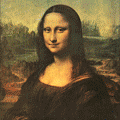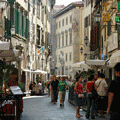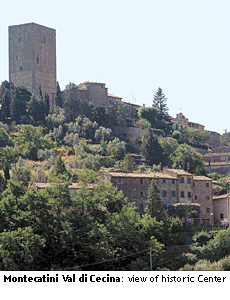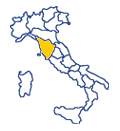
Pisa Hotels

Reserve Pisa Hotels: save up 70% on rooms!
Compare offers & book on line at hotel's web sites. |
|

|
|
Pisa Guide Italy
Volterra and the Val di Cecina
|
|
|
|
|
Volterra and the Val di Cecina
The itinerary could be completed in one or two days. It is worth booking to explore the city and the surrounding area in complete tranquility. You can choose from a selection of hotels in Volterra for a relaxing and charming holiday. If you prefer something a little different, you can choose from the vast selection of inviting apartments, bed and breakfasts and farm holidays in Volterra immersed in the historic center or in the open countryside. Volterra is also an excellent base for anyone wanting to visit Siena and San Gimignano.
The itinerary leads from Pisa to Volterra, through the beautiful landscape which is typical of the Tuscan countryside. From Pisa follow the A12 highway in the direction of Rome and, when you are near Cecina, take the 68 state road for Volterra. By doing so you arrive to the Val di Cecina, countryside full of cypress trees, olive groves and vineyards, with medieval and fortress villages set among the highest hills. If you have time, take a break in Montecatini Val di Cecina. The center of the village has a beautiful small square within a castle, that hosts a church and the Palazzo Pretorio, one of the most authentic corners of Tuscan medieval architecture. The opposite side of the valley boasts Querceto, a charming medieval, fortified village built around a church.
Volterra in ancient times was one of the major Etruscan centers and still conserves some unique traces of this civilization today. But the city is also a gem of Romanesque, medieval and Renaissance art. It is located at 550 meters on a hill that dominates the entire Val di Cecina right up to the sea. Since ancient times, Volterra has been a center renowned for its work in alabaster, as the surrounding land is full of the substance. Still today, shops in the center have craftsmen who work these hot and bright stones.
Passing through the streets of the historic center, you will immediately note the urban layout, with alleys, houses, squares, towers, churches and buildings enclosed within the medieval walls.
The current walls date back to the XIII century and surround the city entirely. They are equipped with watch towers and moats. The southern side of the walls hosts the famous Porta all’Arco gate, dating back to the Etruscan wall from the 4th century B.C. The Etruscan walls were built between the 6th and 5th century B.C. and a considerable amount remain to this day.
The heart of the city is Piazza dei Priori, with its various medieval buildings which include the Palazzo dei Priori. Dating from the 13th century, it is the oldest building in the square. The facade of the building has the coat of arms of the Florentine commissioners who governed the city and the lions on the side pillars. The clock was later added, as were the battlements crowning the building. The entrance door leads to an ornate atrium full of coats of arms and medallions. Palazzo dei Priori is the seat of the Municipality, where you can visit the City Council Hall and the Council Room.
The cathedral is a Romanesque building dating from the 12-13th centuries with a simply decorated facade with a marble portico. The interior consists of three naves divided by granite columns and with walls painted in bands of black and white. In the sixteenth-century various work was carried out, which included the coffered ceiling. The left nave is the location of the valuable pulpit from the 12th century. It was redesigned during the 17th century by supporting it with four small columns.
The baptistery dating from the 13th century is located behind the cathedral. Its octagonal domed shape features a facade covered in white and green marble. Inside, it is quite simple and stark with six cavities in the thick walls; you can admire the different works of art, the most important of which is the Sansovino baptismal font in white marble dating from 1502 to the left of the altar. The large baptismal font, however, dates to 1760 and contrasts with the somber surroundings of the baptistery.
Palazzo Incontri Viti is one of the most beautiful private residences in Italy and a splendid example of a Renaissance building. Two wings of the building remain unfinished and contain two cloisters. In 1850 the alabaster dealer Benedetto Giuseppe Viti bought the building and restored it. In 1964 the director Luchino Visconti shot the film “Sandra Of A Thousand Delights" there, which won a Golden Lion in Venice. The building is today open to the public. The 12 rooms are full of furniture, paintings, porcelain and art collections which represent Italian, European and Eastern art from the 15th to 20th centuries.
The Medicea Fortress is a huge military complex built on the top of the hills and one of the strongest fortresses in Renaissance architecture. It is composed of two distinct parts: the ancient fortress dates back to the fourteenth-century. It is of a trapezoidal shape with a strong circular keep in the center. The New Fortress was built by Lorenzo The Magnificent between 1472 and 1475. The four sided layout has strong corner towers, with the center hosting the monumental Mastio tower. The two fortresses are connected by a long building and the location of the barracks and prisons, which are still in use today.
The Roman Theater is located near the medieval walls leaving from Porta Fiorentina. There are 19 remaining rows of central and lower seats and part of the stage structure and columns.
Volterra contains some interesting museums. The Etruscan Museum preserves archeological materials of considerable interest, including a collection of 600 Etruscan urns, in tufa, alabaster and terracotta and the famous bronze statue entitled "The Shadow of the Night", which has become an authentic symbol of the city. The Alabaster History Museum includes splendid works of art in alabaster subdivided by era: from a cinerary urn from the medieval period, right up to the Renaissance and then the nineteenth-century.
Photos courtesy of APT Pisa
Go to directories of the Web Sites
|
|
|
|
|
Acquista la tua visibilità su Travel Plan
|
|
|
|





